

Cryptographie asymétrique. Un article de Wikipédia, l'encyclopédie libre.
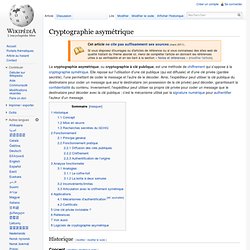
La cryptographie asymétrique, ou cryptographie à clé publique, est une méthode de chiffrement qui s'oppose à la cryptographie symétrique. Elle repose sur l'utilisation d'une clé publique (qui est diffusée) et d'une clé privée (gardée secrète), l'une permettant de coder le message et l'autre de le décoder. Ainsi, l'expéditeur peut utiliser la clé publique du destinataire pour coder un message que seul le destinataire (en possession de la clé privée) peut décoder, garantissant la confidentialité du contenu.
Tech Industry. Innovation de rupture: comment rechercher l’inimaginable. Au milieu des années 80, Garry Hamel, un des grands gourous californiens du management, avait jeté un pavé dans la mare : l’ère du progrès conventionnel et linéaire était révolue.
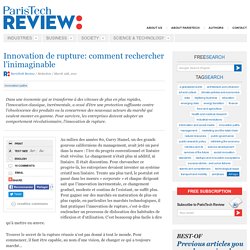
Le changement n’était plus ni additif, ni linéaire. Il était discontinu. Pour chevaucher ce progrès-là, les entreprises devaient inventer un système créatif non linéaire. Trente ans plus tard, le postulat est passé dans les mœurs « corporate » et chaque dirigeant sait que l’innovation incrémentale, ce changement graduel, modeste et continu de l’existant, ne suffit plus.
Pour gagner sur des marchés en maturation de plus en plus rapide, en particulier les marchés technologiques, il faut pratiquer l’innovation de rupture, c’est-à-dire enclencher un processus de dislocation des habitudes de réflexion et d’utilisation. Trouver le secret de la rupture réussie n’est pas donné à tout le monde. No more lists: The robotics approach to idea management — Online Collaboration. Social media is great for sharing and promoting ideas within communities.
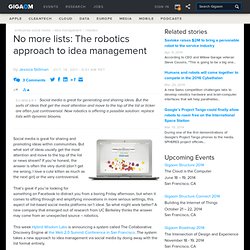
But what sort of ideas usually get the most attention and move to the top of the list or news stream? If you’re honest, the answer is often the very dumb (don’t get me wrong, I love a cute kitten as much as the next girl) or the very controversial. That’s great if you’re looking for something on Facebook to distract you from a boring Friday afternoon, but when it comes to sifting through and amplifying innovations in more serious settings, this aspect of list-based social media platforms isn’t ideal. So what might work better? A new company that emerged out of research from UC Berkeley thinks the answer may come from an unexpected source – robotics.
This week Hybrid Wisdom Labs is announcing a system called The Collaborative Discovery Engine at the Web 2.0 Summit Conference in San Francisco. “It scales to support thousands of participants without sacrificing speed in finding the best solutions,” says Wong. Internet and Civilizationnal changes. Influences du web et d'Internet sur la société.
Pattie Maes and Pranav Mistry demo SixthSense. 60seconds-internet.jpg (1191×842) Surfer sans entraves. Map/envisioning-technology-2011-02-25.pdf.
Social Networks. Learning to code. String [ruby-doc.org] Str % arg → new_str click to toggle source Format—Uses str as a format specification, and returns the result of applying it to arg.
![String [ruby-doc.org]](http://cdn.pearltrees.com/s/pic/th/class-string-ruby-2-1-80968642)
If the format specification contains more than one substitution, then arg must be an Array or Hash containing the values to be substituted. How to install Ruby on Mac. This one is tailor made for the Basix users among you.
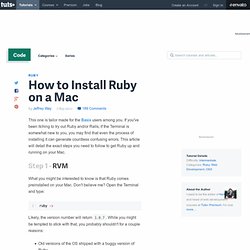
If you've been itching to try out Ruby and/or Rails, if the Terminal is somewhat new to you, you may find that even the process of installing it can generate countless confusing errors. This article will detail the exact steps you need to follow to get Ruby up and running on your Mac. Programming Ruby 1.9. About this Book 944 pages Published: Release: P5.0 (2012-10-16) ISBN: 978-1-93435-608-1 Would you like to go from first idea to working code much, much faster?

Do you currently spend more time satisfying the compiler instead of your clients or end users? Are you frustrated with demanding languages that seem to get in your way, instead of getting the work done? Are you using Rails, and want to dig deeper into the underlying Ruby language? Ruby is a fully object-oriented language, much like the classic object-oriented language, Smalltalk. The combination of the power of a pure object-oriented language with the convenience of a scripting language makes Ruby a favorite tool of intelligent, forward-thinking programmers. Programming Ruby.
About this Book. Foreign key. The table containing the foreign key is called the referencing or child table, and the table containing the candidate key is called the referenced or parent table.[4] For example, consider a database with two tables: a CUSTOMER table that includes all customer data and an ORDER table that includes all customer orders.
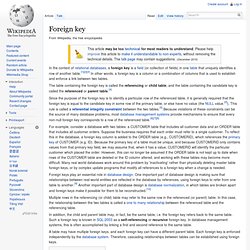
Suppose the business requires that each order must refer to a single customer. To reflect this in the database, a foreign key column is added to the ORDER table (e.g., CUSTOMERID), which references the primary key of CUSTOMER (e.g. ID). Because the primary key of a table must be unique, and because CUSTOMERID only contains values from that primary key field, we may assume that, when it has a value, CUSTOMERID will identify the particular customer which placed the order. Foreign keys play an essential role in database design. In addition, the child and parent table may, in fact, be the same table, i.e. the foreign key refers back to the same table. Try ruby! (in your browser) Code School - RailsForZombies. Code School - Rails for Zombies. Holy Shmoly, Ruby 1.9 smokes Python away! Posted on Nov 28th, 2007 in Programming | 104 comments Alright the title of this post is a tad sensational sounding, I know, and it’s in part aimed at messing with my many Pythonista friends.
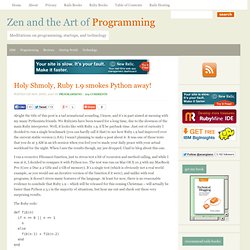
We Rubyists have been teased for a long time, due to the slowness of the main Ruby interpreter. Well, it looks like with Ruby 1.9, it’ll be payback time. Just out of curiosity I decided to run a single benchmark (you can hardly call it that) to see how Ruby 1.9 had improved over the current stable version (1.8.6). I wasn’t planning to make a post about it. Le Site du Zéro, site communautaire de tutoriels gratuits pour débutants : programmation, création de sites Web, Linux...